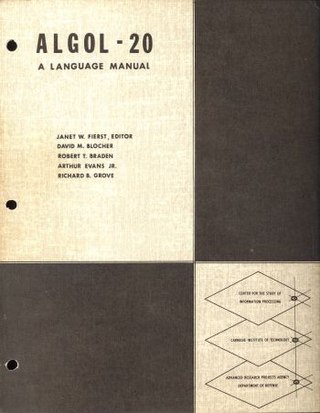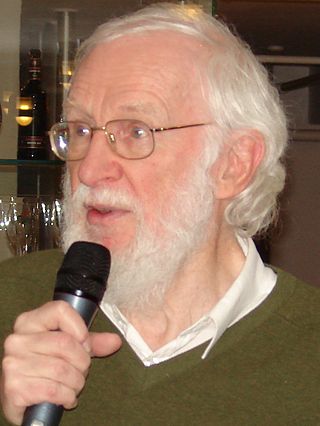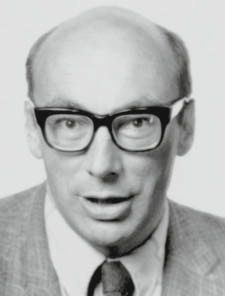Related Research Articles

ALGOL is a family of imperative computer programming languages originally developed in 1958. ALGOL heavily influenced many other languages and was the standard method for algorithm description used by the Association for Computing Machinery (ACM) in textbooks and academic sources for more than thirty years.

Peter Naur was a Danish computer science pioneer and 2005 Turing award winner. He is best remembered as a contributor, with John Backus, to the Backus–Naur form (BNF) notation used in describing the syntax for most programming languages. He also contributed to creating the language ALGOL 60.
In computer science, Backus–Naur form is a notation used to describe the syntax of programming languages or other formal languages. It was developed by John Backus and Peter Naur. BNF can be described as a metasyntax notation for context-free grammars. Backus–Naur form is applied wherever exact descriptions of languages are needed, such as in official language specifications, in manuals, and in textbooks on programming language theory. BNF can be used to describe document formats, instruction sets, and communication protocols.
ALGOL W is a programming language. It is based on a proposal for ALGOL X by Niklaus Wirth and Tony Hoare as a successor to ALGOL 60. ALGOL W is a relatively simple upgrade of the original ALGOL 60, adding string, bitstring, complex number and reference to record data types and call-by-result passing of parameters, introducing the while statement, replacing switch with the case statement, and generally tightening up the language.
The Burroughs Large Systems Group produced a family of large 48-bit mainframes using stack machine instruction sets with dense syllables. The first machine in the family was the B5000 in 1961, which was optimized for compiling ALGOL 60 programs extremely well, using single-pass compilers. The B5000 evolved into the B5500 and the B5700. Subsequent major redesigns include the B6500/B6700 line and its successors, as well as the separate B8500 line.
In computer programming, a block or code block or block of code is a lexical structure of source code which is grouped together. Blocks consist of one or more declarations and statements. A programming language that permits the creation of blocks, including blocks nested within other blocks, is called a block-structured programming language. Blocks are fundamental to structured programming, where control structures are formed from blocks.

Peter John Landin was a British computer scientist. He was one of the first to realise that the lambda calculus could be used to model a programming language, an insight that is essential to the development of both functional programming and denotational semantics.
ALGOL 60 is a member of the ALGOL family of computer programming languages. It followed on from ALGOL 58 which had introduced code blocks and the begin and end pairs for delimiting them, representing a key advance in the rise of structured programming. ALGOL 60 was one of the first languages implementing function definitions. ALGOL 60 function definitions could be nested within one another, with lexical scope. It gave rise to many other languages, including CPL, PL/I, Simula, BCPL, B, Pascal, and C. Practically every computer of the era had a systems programming language based on ALGOL 60 concepts.

Roger D. Moore was the 1973 recipient of the Grace Murray Hopper Award from the Association for Computing Machinery (ACM). It was given "for their work in the design and implementation of APL\360, setting new standards in simplicity, efficiency, reliability and response time for interactive systems."
In computer programming, a statement is a syntactic unit of an imperative programming language that expresses some action to be carried out. A program written in such a language is formed by a sequence of one or more statements. A statement may have internal components.
The TPK algorithm is a simple program introduced by Donald Knuth and Luis Trabb Pardo to illustrate the evolution of computer programming languages. In their 1977 work "The Early Development of Programming Languages", Trabb Pardo and Knuth introduced a small program that involved arrays, indexing, mathematical functions, subroutines, I/O, conditionals and iteration. They then wrote implementations of the algorithm in several early programming languages to show how such concepts were expressed.

The Z22 was the seventh computer model Konrad Zuse developed. One of the early commercial computers, the Z22's design was finished about 1955. The major version jump from Z11 to Z22 was due to the use of vacuum tubes, as opposed to the electromechanical systems used in earlier models. The first machines built were shipped to Berlin and Aachen.

Friedrich Ludwig "Fritz" Bauer was a German pioneer of computer science and professor at the Technical University of Munich.
Klaus Samelson was a German mathematician, physicist, and computer pioneer in the area of programming language translation and push-pop stack algorithms for sequential formula translation on computers.

In computing, a compiler is a computer program that transforms source code written in a programming language or computer language, into another computer language. The most common reason for transforming source code is to create an executable program.

Heinz Rutishauser was a Swiss mathematician and a pioneer of modern numerical mathematics and computer science.
Dartmouth ALGOL 30 was a 1960s-era implementation, first of the ALGOL 58 programming language and then of ALGOL 60. It is named after the computer on which it ran: a Librascope General Precision (LGP-30) desk-size computer acquired by Dartmouth College in 1959.
Hermann Bottenbruch was a German mathematician and computer scientist.
Joseph Henry Wegstein was an American computer scientist.
References
- ↑ Rojas, Raúl; Hashagen, Ulf (2002). The First Computers: History and Architectures. MIT Press. p. 292. ISBN 978-0262681377 . Retrieved October 25, 2013.
- ↑ Backus, J.W. (1959). "The Syntax and Semantics of the Proposed International Algebraic Language of Zürich ACM-GAMM Conference". Proceedings of the International Conference on Information Processing. UNESCO. pp. 125–132.
- ↑ Aspray, William (17 February 1987), An interview with Friedrich L. Bauer (PDF), Charles Babbage Institute, archived from the original (PDF) on April 22, 2012
- 1 2 3 Goos, Gerhard [in German] (2017-08-07). Geschichte der deutschsprachigen Informatik - Programmiersprachen und Übersetzerbau [History of informatics in German-speaking countries - Programming languages and compiler design](PDF) (in German). Karlsruhe, Germany: Fakultät für Informatik, Karlsruhe Institute of Technology (KIT). Archived (PDF) from the original on 2022-05-19. Retrieved 2022-11-14. (11 pages)
- ↑ Perlis, A.J. (1981). "Talk on Computing in the fifties". ACM National Conference. Nashville, TN. Los Alamito, CA: (Transcript in J. A. N. Lee (ed.), Computer Pioneers, IEEE Computer Society Press (published 1995). pp. 545–556).
- ↑ Perlis, A.J.; Samelson, K. (1958). "Preliminary report: international algebraic language". Communications of the ACM. 1 (12): 8–22. doi: 10.1145/377924.594925 . S2CID 28755282.
- ↑ "Algol 58 implementations and dialects", Software Preservation Group, Computer History Museum. Donald Knuth is quoted on BALGOL: "I’m in my second year at Caltech, and I was a consultant to Burroughs. After finishing my compiler for Burroughs, I joined the Product Planning Department. The Product Planning Department was largely composed of people who had written the best software ever done in the world up to that time, which was a Burroughs ALGOL compiler for the 220 computer. That was a great leap forward for software. It was the first software that used list processing and high level data structures in an intelligent way. They took the ideas of Newell and Simon and applied them to compilers. It ran circles around all the other things that we were doing." [Don Knuth, CHM Oral History, 2007, page 9]
- ↑ Naur, P, ed. (1962). Revised report on the Algorithmic Language ALGOL 60 (PDF). International Federation for Information Processing.